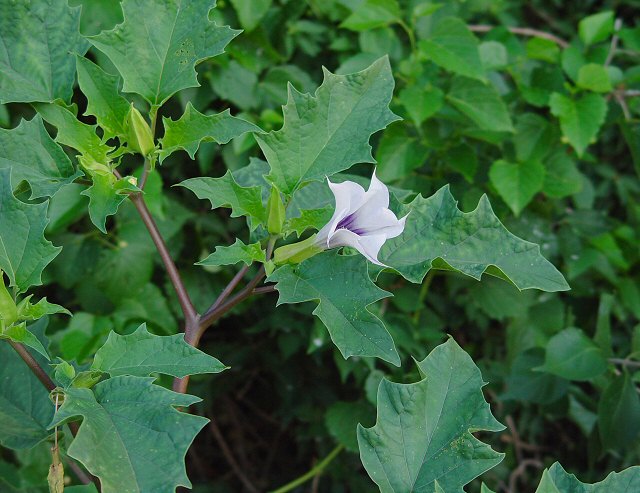Datura stramonium L.
Common Jimsonweed

Introduced
CC = *
CW = 5
MOC = 55
© DETenaglia
Datura stramonium L.Common Jimsonweed | |
 |
Introduced CC = * CW = 5 MOC = 55 |
© DETenaglia |
|
Family - Solanaceae Habit - Taprooted annual forb. Stems - Ascending to erect, to 1.2 m, branched, sparsely to moderately pubescent toward the tip with curled, nonglandular hairs.
Leaves - Alternate, simple, petiolate. Blades 5-20 cm long, ovate to narrowly ovate, angled or tapered to a sharply pointed tip, broadly angled to truncate at the base, the margins coarsely and sharply lobed and/or toothed, the surfaces (especially the undersurface) sparsely pubescent along and between the veins at maturity with minute hairs 0.1-0.4 mm long, more densely so when young.
Inflorescence - Solitary flowers, initially terminal, later produced in axils of branched nodes. Flowers - Flower stalks 0.5-1.5 cm long. Calyces 3-5 cm long, tubular but strongly 5-angled to narrowly winged along the sides, finely hairy, the persistent base 4-7 mm long, usually reflexed at fruiting. Corollas 6-10 cm long, funnelform, white to partially pale to dark purplish-tinged or more uniformly light purple. Stamens with relatively long filaments, erect, positioned in a loose ring, not exserted, dehiscent longitudinally, light yellow to nearly white, usually hairy. Ovary 2-carpellate but appearing 4-locular, the style elongate, positioned at about the level of the anthers, green.
Fruits - Capsules 3-5 cm long, erect, more or less globose to more commonly broadly oblong-ovoid, the surface minutely hairy and densely prickly, the prickles 3-5 mm long. Seeds 3-4 mm in longest dimension, the surface finely pitted and often finely wrinkled, sometimes only faintly so, lacking a pair of dorsal grooves, more or less shiny, dark gray to black.
Flowering - May - October. Habitat - Pastures, barnyards, fields, waste ground, cultivated areas, roadsides, railroads. Origin - Native to tropical America, possibly the southwestern U.S. Lookalikes - Other species of Datura, which are rare in Missouri. Other info. - This toxic species can be found scattered throughout most of Missouri. It also occurs across most of the continental U.S., most frequently in the eastern half of the country. It is easily identified by its nearly glabrous stems, toothed leaves, large flowers, and spiked fruits. The entire plant is usually faintly to moderately malodorous. Photographs taken along Logan Creek, Ellington, MO., 8-1-04, and off Missouri Bottom Rd, St. Louis, MO., 8-7-05 (DETenaglia); also at Weldon Spring Conservation Area, St. Charles County, MO, 10-04-2012, and along the Katy Trail near Augusta, St. Charles County, MO, 9-20-2017 (SRTurner). |